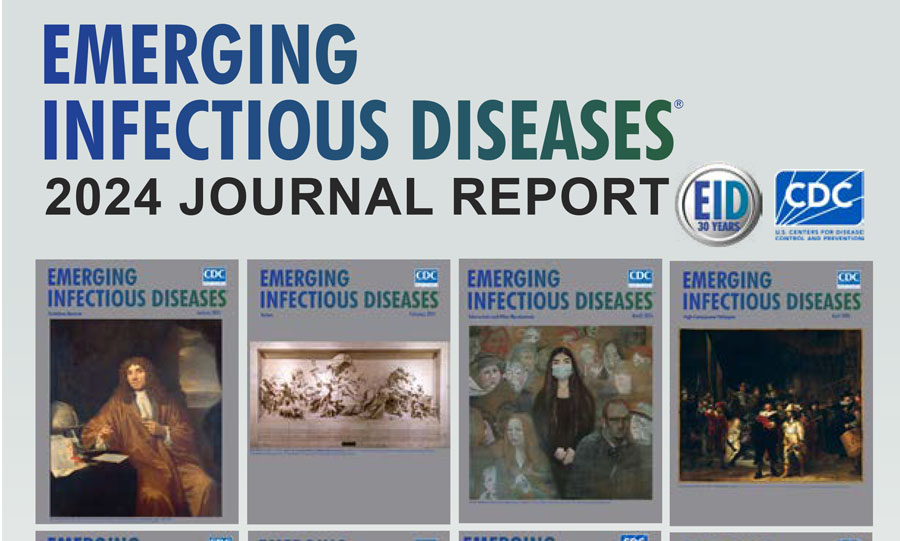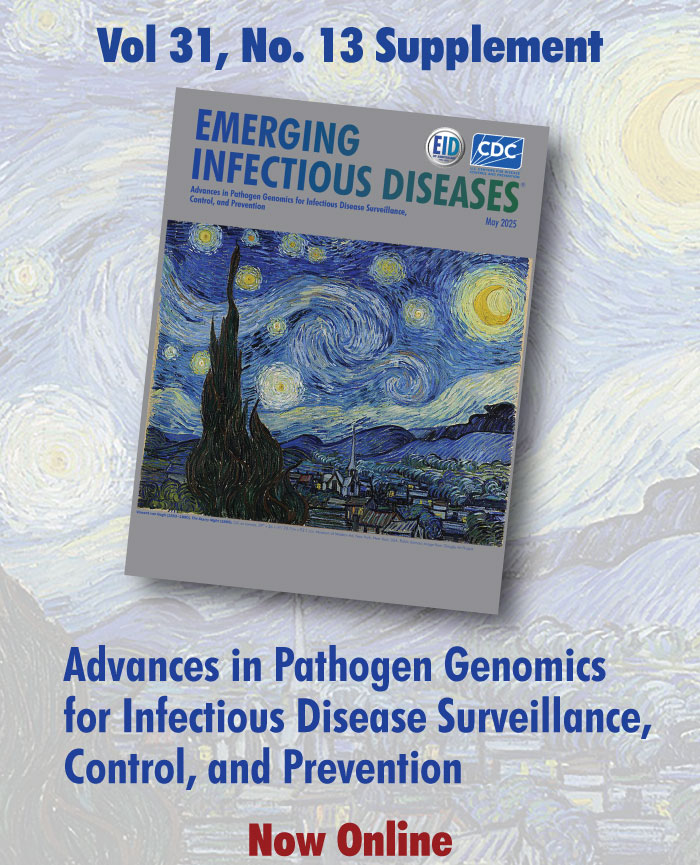Medscape CME Activity
Medscape, LLC is pleased to provide online continuing medical education (CME) for selected journal articles, allowing clinicians the opportunity to earn CME credit. In support of improving patient care, these activities have been planned and implemented by Medscape, LLC and Emerging Infectious Diseases. Medscape, LLC is jointly accredited by the Accreditation Council for Continuing Medical Education (ACCME), the Accreditation Council for Pharmacy Education (ACPE), and the American Nurses Credentialing Center (ANCC), to provide continuing education for the healthcare team.
CME credit is available for one year after publication.
Volume 27—2021
Volume 27, Number 12—December 2021
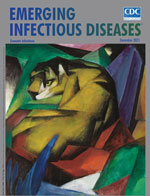
To determine differences in clinical characteristics of patients with bacteremia caused by Corynebacterium striatum, C. jeikeium, and other species of Corynebacterium, we retrospectively reviewed medical records of patients in Japan who had Corynebacterium bacteremia during January 2014–May 2020. Of the 115 records evaluated, 60 (52%) were cases of true bacteremia and 55 (48%) were cases of contamination. Proportions of true bacteremia cases caused by C. striatum (70%) and by C. jeikeium (71%) were significantly higher than those caused by other species of Corynebacterium (9%). These 2 organisms were commonly detected in blood cultures of patients with hematologic malignancies and neutropenia. The mortality rates at 90 days were 34% (C. striatum), 30% (C. jeikeium), and 0 (other species). Given the high mortality rates, assessing true bacteremia when C. striatum or C. jeikeium is detected in blood cultures, especially in patients with hematologic malignancy, is warranted.
| EID | Yamamuro R, Hosokawa N, Otsuka Y, Osawa R. Clinical Characteristics of Corynebacterium Bacteremia Caused by Different Species, Japan, 2014–2020. Emerg Infect Dis. 2021;27(12):2981-2987. https://doi.org/10.3201/eid2712.210473 |
|---|---|
| AMA | Yamamuro R, Hosokawa N, Otsuka Y, et al. Clinical Characteristics of Corynebacterium Bacteremia Caused by Different Species, Japan, 2014–2020. Emerging Infectious Diseases. 2021;27(12):2981-2987. doi:10.3201/eid2712.210473. |
| APA | Yamamuro, R., Hosokawa, N., Otsuka, Y., & Osawa, R. (2021). Clinical Characteristics of Corynebacterium Bacteremia Caused by Different Species, Japan, 2014–2020. Emerging Infectious Diseases, 27(12), 2981-2987. https://doi.org/10.3201/eid2712.210473. |
We conducted a territorywide survey to investigate the epidemiology, risk factors, and clinical outcomes of Clostridioides difficile infection (CDI) among hospitalized patients in Hong Kong. A total of 17,105 cases of CDI were identified, of which 15,717 (91.9%) were healthcare-associated and 1,025 (6.0%) were community-associated. Although CDI incidence increased substantially from 2006 to 2017, it plateaued in 2018 and 2019. The 30-day mortality rates decreased from 20.1% in 2015 to 16.8% in 2019, whereas the 60-day recurrence rates remained constant at ≈11% during the study period. Cross-correlation statistic showed significant correlations between incidence trend and overall antimicrobial drug use (r = 0.865, p<0.001), which has decreased as a result of an antibiotic stewardship program initiated in 2017. Our data suggest a turning point in C. difficile epidemiology that could be related to the changing pattern of antimicrobial drug use.
| EID | Guo C, Kwong T, Mak J, Zhang L, Lui G, Wong G, et al. Trends in Incidence and Clinical Outcomes of Clostridioides difficile Infection, Hong Kong. Emerg Infect Dis. 2021;27(12):3036-3044. https://doi.org/10.3201/eid2712.203769 |
|---|---|
| AMA | Guo C, Kwong T, Mak J, et al. Trends in Incidence and Clinical Outcomes of Clostridioides difficile Infection, Hong Kong. Emerging Infectious Diseases. 2021;27(12):3036-3044. doi:10.3201/eid2712.203769. |
| APA | Guo, C., Kwong, T., Mak, J., Zhang, L., Lui, G., Wong, G....Wong, S. H. (2021). Trends in Incidence and Clinical Outcomes of Clostridioides difficile Infection, Hong Kong. Emerging Infectious Diseases, 27(12), 3036-3044. https://doi.org/10.3201/eid2712.203769. |
Volume 27, Number 11—November 2021
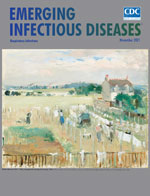
Ehrlichiosis and anaplasmosis are emerging tickborne diseases that can also be transmitted through blood transfusions or organ transplants. Since 2000, ehrlichiosis and anaplasmosis cases in the United States have increased substantially, resulting in potential risk to transplant and transfusion recipients. We reviewed ehrlichiosis and anaplasmosis cases among blood transfusion and solid organ transplant recipients in the United States from peer-reviewed literature and Centers for Disease Control and Prevention investigations. We identified 132 cases during 1997–2020, 12 transfusion-associated cases and 120 cases in transplant recipients; 8 cases were donor-derived, and in 13 cases illness occurred <1 year after transplant. Disease in the remaining 99 cases occurred ≥1 year after transplant, suggesting donor-derived disease was unlikely. Severe illness or death were reported among 15 transfusion and transplant recipients. Clinicians should be alert for these possible infections among transfusion and transplant recipients to prevent severe complications or death by quickly treating them.
| EID | Mowla SJ, Drexler NA, Cherry CC, Annambholta PD, Kracalik IT, Basavaraju SV. Ehrlichiosis and Anaplasmosis among Transfusion and Transplant Recipients in the United States. Emerg Infect Dis. 2021;27(11):2768-2775. https://doi.org/10.3201/eid2711.211127 |
|---|---|
| AMA | Mowla SJ, Drexler NA, Cherry CC, et al. Ehrlichiosis and Anaplasmosis among Transfusion and Transplant Recipients in the United States. Emerging Infectious Diseases. 2021;27(11):2768-2775. doi:10.3201/eid2711.211127. |
| APA | Mowla, S. J., Drexler, N. A., Cherry, C. C., Annambholta, P. D., Kracalik, I. T., & Basavaraju, S. V. (2021). Ehrlichiosis and Anaplasmosis among Transfusion and Transplant Recipients in the United States. Emerging Infectious Diseases, 27(11), 2768-2775. https://doi.org/10.3201/eid2711.211127. |
Volume 27, Number 10—October 2021
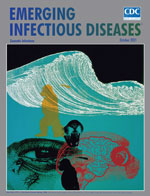
Babesiosis developed in a 62-year-old immunocompetent physician, who had an uneventful recovery after receiving atovaquone and azithromycin. Three years later, babesiosis developed again, and he was again successfully given treatment. Clinical and laboratory evidence were highly supportive of Babesia reinfection. Healthcare professionals should be aware that reinfection might occur in babesiosis.
| EID | Ho J, Carey E, Carey DE, Krause PJ. Recurrence of Human Babesiosis Caused by Reinfection. Emerg Infect Dis. 2021;27(10):2658-2661. https://doi.org/10.3201/eid2710.211240 |
|---|---|
| AMA | Ho J, Carey E, Carey DE, et al. Recurrence of Human Babesiosis Caused by Reinfection. Emerging Infectious Diseases. 2021;27(10):2658-2661. doi:10.3201/eid2710.211240. |
| APA | Ho, J., Carey, E., Carey, D. E., & Krause, P. J. (2021). Recurrence of Human Babesiosis Caused by Reinfection. Emerging Infectious Diseases, 27(10), 2658-2661. https://doi.org/10.3201/eid2710.211240. |
We evaluated the incidence, outcomes, and causative agents of bloodstream infections (BSI) in Finland during 2004–2018 by using data from the national registries. We identified a total of 173,715 BSIs; annual incidence increased from 150 to 309 cases/100,000 population. BSI incidence rose most sharply among persons >80 years of age. The 1-month case-fatality rate decreased from 13.0% to 12.6%, but the 1-month all-cause mortality rate rose from 20 to 39 deaths/100,000 population. BSIs caused by Escherichia coli increased from 26% to 30% of all BSIs. BSIs caused by multidrug-resistant microbes rose from 0.4% to 2.8%, mostly caused by extended-spectrum β-lactamase-producing E. coli. We observed an increase in community-acquired BSIs, from 67% to 78%. The proportion of patients with severe underlying conditions rose from 14% to 23%. Additional public health and healthcare prevention efforts are needed to curb the increasing trend in community-acquired BSIs and antimicrobial drug–resistant E. coli.
| EID | Kontula K, Skogberg K, Ollgren J, Järvinen A, Lyytikäinen O. Population-Based Study of Bloodstream Infection Incidence and Mortality Rates, Finland, 2004–2018. Emerg Infect Dis. 2021;27(10):2560-2569. https://doi.org/10.3201/eid2710.204826 |
|---|---|
| AMA | Kontula K, Skogberg K, Ollgren J, et al. Population-Based Study of Bloodstream Infection Incidence and Mortality Rates, Finland, 2004–2018. Emerging Infectious Diseases. 2021;27(10):2560-2569. doi:10.3201/eid2710.204826. |
| APA | Kontula, K., Skogberg, K., Ollgren, J., Järvinen, A., & Lyytikäinen, O. (2021). Population-Based Study of Bloodstream Infection Incidence and Mortality Rates, Finland, 2004–2018. Emerging Infectious Diseases, 27(10), 2560-2569. https://doi.org/10.3201/eid2710.204826. |
Tickborne relapsing fever spirochetes are an overlooked cause of disease around the globe. We report a case of tickborne relapsing fever in a patient in Texas, USA, who had a single febrile episode and gastrointestinal and neurologic symptoms. Immunoblot analysis using recombinant Borrelia immunogenic protein A implicated Borrelia turicatae as the causative agent.
| EID | Ellis L, Curtis MW, Gunter SM, Lopez JE. Relapsing Fever Infection Manifesting as Aseptic Meningitis, Texas, USA. Emerg Infect Dis. 2021;27(10):2681-2685. https://doi.org/10.3201/eid2710.210189 |
|---|---|
| AMA | Ellis L, Curtis MW, Gunter SM, et al. Relapsing Fever Infection Manifesting as Aseptic Meningitis, Texas, USA. Emerging Infectious Diseases. 2021;27(10):2681-2685. doi:10.3201/eid2710.210189. |
| APA | Ellis, L., Curtis, M. W., Gunter, S. M., & Lopez, J. E. (2021). Relapsing Fever Infection Manifesting as Aseptic Meningitis, Texas, USA. Emerging Infectious Diseases, 27(10), 2681-2685. https://doi.org/10.3201/eid2710.210189. |
Volume 27, Number 9—September 2021
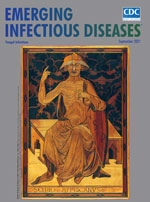
We retrospectively investigated mother-to-infant transmission of group B Streptococcus (GBS) in 98 cases of late-onset disease reported during 2007–2018 by a network in Italy. Mothers with full assessment of vaginal/rectal carriage tested at prenatal screening and at time of late onset (ATLO) were included. Thirty-three mothers (33.7%) were never GBS colonized; 65 (66.3%) were vaginal/rectal colonized, of which 36 (36.7%) were persistently colonized. Mothers with vaginal/rectal colonization ATLO had high rates of GBS bacteriuria (33.9%) and positive breast milk culture (27.5%). GBS strains from mother–infant pairs were serotype III and possessed the surface protein antigen Rib. All but 1 strain belonged to clonal complex 17. GBS strains from 4 mother–infant pairs were indistinguishable through pulsed-field gel electrophoresis. At least two thirds of late-onset cases are transmitted from mothers, who often have vaginal/rectal carriage, positive breast milk culture, or GBS bacteriuria, which suggests heavy maternal colonization.
| EID | Berardi A, Spada C, Creti R, Auriti C, Gambini L, Rizzo V, et al. Maternal Carriage in Late-Onset Group B Streptococcus Disease, Italy. Emerg Infect Dis. 2021;27(9):2279-2287. https://doi.org/10.3201/eid2709.210049 |
|---|---|
| AMA | Berardi A, Spada C, Creti R, et al. Maternal Carriage in Late-Onset Group B Streptococcus Disease, Italy. Emerging Infectious Diseases. 2021;27(9):2279-2287. doi:10.3201/eid2709.210049. |
| APA | Berardi, A., Spada, C., Creti, R., Auriti, C., Gambini, L., Rizzo, V....Lugli, L. (2021). Maternal Carriage in Late-Onset Group B Streptococcus Disease, Italy. Emerging Infectious Diseases, 27(9), 2279-2287. https://doi.org/10.3201/eid2709.210049. |
Volume 27, Number 8—August 2021

Because of widespread use of probiotics, their safety must be guaranteed. We assessed use of Saccharomyces boulardii probiotic yeast from medical records for patients who had Saccharomyces fungemia or other clinical Saccharomyces culture findings. We evaluated all Saccharomyces sp. findings at 5 university hospitals in Finland during 2009–2018. We found 46 patients who had Saccharomyces fungemia; at least 20 (43%) were using S. boulardii probiotic. Compared with a control group that had bacteremia or candidemia, the odds ratio for use of an S. boulardii probiotic was 14 (95% CI 4–44). Of 1,153 nonblood culture findings, the history for 125 patients was checked; at least 24 (19%) were using the probiotic (odds ratio 10, 95% CI 3–32). This study adds to published fungemia cases linked to use of S. boulardii probiotic and sheds light on the scale of nonblood Saccharomyces culture findings that are also linked to use of this probiotic.
| EID | Rannikko J, Holmberg V, Karppelin M, Arvola P, Huttunen R, Mattila E, et al. Fungemia and Other Fungal Infections Associated with Use of Saccharomyces boulardii Probiotic Supplements. Emerg Infect Dis. 2021;27(8):2043-2051. https://doi.org/10.3201/eid2708.210018 |
|---|---|
| AMA | Rannikko J, Holmberg V, Karppelin M, et al. Fungemia and Other Fungal Infections Associated with Use of Saccharomyces boulardii Probiotic Supplements. Emerging Infectious Diseases. 2021;27(8):2043-2051. doi:10.3201/eid2708.210018. |
| APA | Rannikko, J., Holmberg, V., Karppelin, M., Arvola, P., Huttunen, R., Mattila, E....Hohenthal, U. (2021). Fungemia and Other Fungal Infections Associated with Use of Saccharomyces boulardii Probiotic Supplements. Emerging Infectious Diseases, 27(8), 2043-2051. https://doi.org/10.3201/eid2708.210018. |
During 3 weeks in 2019, 4 human cases of Eastern equine encephalitis (EEE) were diagnosed at a single hospital in Connecticut, USA. The cases coincided with notable shifts in vector–host infection patterns in the northeastern United States and signified a striking change in EEE incidence. All 4 cases were geographically clustered, rapidly progressive, and neurologically devastating. Diagnostic tests conducted by a national commercial reference laboratory revealed initial granulocytic cerebrospinal fluid pleocytosis and false-negative antibody results. EEE virus infection was diagnosed only after patient samples were retested by the arbovirus laboratory of the Centers for Disease Control and Prevention in Fort Collins, Colorado, USA. The crucial diagnostic challenges, clinical findings, and epidemiologic patterns revealed in this outbreak can inform future public health and clinical practice.
| EID | Brown SC, Cormier J, Tuan J, Lier AJ, McGuone D, Armstrong PM, et al. Four Human Cases of Eastern Equine Encephalitis in Connecticut, USA, during a Larger Regional Outbreak, 2019. Emerg Infect Dis. 2021;27(8):2042-2051. https://doi.org/10.3201/eid2708.203730 |
|---|---|
| AMA | Brown SC, Cormier J, Tuan J, et al. Four Human Cases of Eastern Equine Encephalitis in Connecticut, USA, during a Larger Regional Outbreak, 2019. Emerging Infectious Diseases. 2021;27(8):2042-2051. doi:10.3201/eid2708.203730. |
| APA | Brown, S. C., Cormier, J., Tuan, J., Lier, A. J., McGuone, D., Armstrong, P. M....Gobeske, K. T. (2021). Four Human Cases of Eastern Equine Encephalitis in Connecticut, USA, during a Larger Regional Outbreak, 2019. Emerging Infectious Diseases, 27(8), 2042-2051. https://doi.org/10.3201/eid2708.203730. |
Volume 27, Number 7—July 2021
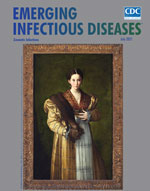
Usually responsible for soft tissue infections, Clostridioides species can also cause bacteremia, life-threatening infections often requiring intensive care unit (ICU) admission. We conducted a multicenter retrospective study to investigate Clostridioides bacteremia in ICUs to describe the clinical and biologic characteristics and outcomes in critically ill patients. We identified 135 patients with Clostridioides bacteremia, which occurred almost exclusively (96%) in patients with underlying conditions. Septic shock and digestive symptoms were the hallmarks of Clostridioides bacteremia in the ICU. We identified 16 different species of Clostridioides, among which C. perfringens accounted for 31% of cases. Despite the high sensitivity of Clostridioides to common antimicrobial drugs, mortality rates were high: 52% for ICU patients and 71% overall at 3 months. In multivariate analysis, the most important factor associated with increased risk for death was the presence of hemolysis. Clostridioides bacteremia often leads to multiple organ failures, which have high mortality rates.
| EID | Morel G, Mulier G, Ghrenassia E, Abdel Nabey M, Tandjaoui Y, Kouatchet A, et al. Non–C. difficile Clostridioides Bacteremia in Intensive Care Patients, France. Emerg Infect Dis. 2021;27(7):1840-1849. https://doi.org/10.3201/eid2707.203471 |
|---|---|
| AMA | Morel G, Mulier G, Ghrenassia E, et al. Non–C. difficile Clostridioides Bacteremia in Intensive Care Patients, France. Emerging Infectious Diseases. 2021;27(7):1840-1849. doi:10.3201/eid2707.203471. |
| APA | Morel, G., Mulier, G., Ghrenassia, E., Abdel Nabey, M., Tandjaoui, Y., Kouatchet, A....Zafrani, L. (2021). Non–C. difficile Clostridioides Bacteremia in Intensive Care Patients, France. Emerging Infectious Diseases, 27(7), 1840-1849. https://doi.org/10.3201/eid2707.203471. |
Volume 27, Number 6—June 2021
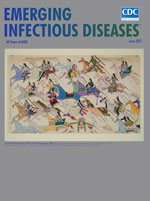
Yellow fever (YF) vaccine can cause neurologic complications. We examined YF vaccine–associated neurologic disease reported from 3 tertiary referral centers in São Paulo, Brazil, during 2017–2018 and compared the performance of criteria established by the Yellow Fever Vaccine Working Group/Centers for Disease Control and Prevention and the Brighton Collaboration. Among 50 patients who met inclusion criteria, 32 had meningoencephalitis (14 with reactive YF IgM in cerebrospinal fluid), 2 died, and 1 may have transmitted infection to an infant through breast milk. Of 7 cases of autoimmune neurologic disease after YF vaccination, 2 were acute disseminated encephalomyelitis, 2 myelitis, and 3 Guillain-Barré syndrome. Neurologic disease can follow fractional vaccine doses, and novel potential vaccine-associated syndromes include autoimmune encephalitis, opsoclonus-myoclonus-ataxia syndrome, optic neuritis, and ataxia. Although the Brighton Collaboration criteria lack direct vaccine causal assessment, they are more inclusive than the Centers for Disease Control and Prevention criteria.
| EID | Ribeiro A, Guedes B, Sulleiman J, de Oliveira F, de Souza I, Nogueira J, et al. Neurologic Disease after Yellow Fever Vaccination, São Paulo, Brazil, 2017–2018. Emerg Infect Dis. 2021;27(6):1577-1587. https://doi.org/10.3201/eid2706.204170 |
|---|---|
| AMA | Ribeiro A, Guedes B, Sulleiman J, et al. Neurologic Disease after Yellow Fever Vaccination, São Paulo, Brazil, 2017–2018. Emerging Infectious Diseases. 2021;27(6):1577-1587. doi:10.3201/eid2706.204170. |
| APA | Ribeiro, A., Guedes, B., Sulleiman, J., de Oliveira, F., de Souza, I., Nogueira, J....de Oliveira, A. (2021). Neurologic Disease after Yellow Fever Vaccination, São Paulo, Brazil, 2017–2018. Emerging Infectious Diseases, 27(6), 1577-1587. https://doi.org/10.3201/eid2706.204170. |
Epidemic levels of Rocky Mountain spotted fever (RMSF) have persisted in Mexicali, Mexico, since the initial outbreak was first reported in December 2008. We compared clinical and epidemiologic data of cases in Mexicali during 2009–2019 between patients with an IgG titer reactive with Rickettsia rickettsii bacteria by indirect immunofluorescence antibody (IFA) assay and those who demonstrated DNA of R. rickettsii in a whole blood sample when tested by PCR. We identified 4,290 patients with clinical and epidemiologic features compatible with RMSF; of these, 9.74% tested positive by IFA and 8.41% by PCR. Overall, 140 patients died (11-year case-fatality rate 17.97%). Substantial differences in the frequency of commonly recognized clinical characteristics of RMSF were identified between PCR-positive and IFA-positive cases. The Mexicali epidemic is unique in its size and urban centralization. Cases confirmed by PCR most accurately reflect the clinical profile of RMSF.
| EID | Zazueta OE, Armstrong PA, Márquez-Elguea A, Hernández Milán N, Peterson AE, Ovalle-Marroquín DF, et al. Rocky Mountain Spotted Fever in a Large Metropolitan Center, Mexico–United States Border, 2009–2019. Emerg Infect Dis. 2021;27(6):1567-1576. https://doi.org/10.3201/eid2706.191662 |
|---|---|
| AMA | Zazueta OE, Armstrong PA, Márquez-Elguea A, et al. Rocky Mountain Spotted Fever in a Large Metropolitan Center, Mexico–United States Border, 2009–2019. Emerging Infectious Diseases. 2021;27(6):1567-1576. doi:10.3201/eid2706.191662. |
| APA | Zazueta, O. E., Armstrong, P. A., Márquez-Elguea, A., Hernández Milán, N., Peterson, A. E., Ovalle-Marroquín, D. F....Paddock, C. D. (2021). Rocky Mountain Spotted Fever in a Large Metropolitan Center, Mexico–United States Border, 2009–2019. Emerging Infectious Diseases, 27(6), 1567-1576. https://doi.org/10.3201/eid2706.191662. |
We determined the effect of HIV infection on deaths among persons >18 months of age with culture-confirmed candidemia at 29 sentinel hospitals in South Africa during 2012–2017. Of 1,040 case-patients with documented HIV status and in-hospital survival data, 426 (41%) were HIV-seropositive. The in-hospital case-fatality rate was 54% (228/426) for HIV-seropositive participants and 37% (230/614) for HIV-seronegative participants (crude odds ratio [OR] 1.92, 95% CI 1.50–2.47; p<0.001). After adjusting for relevant confounders (n = 907), mortality rates were 1.89 (95% CI 1.38–2.60) times higher among HIV-seropositive participants than HIV-seronegative participants (p<0.001). Compared with HIV-seronegative persons, the stratum-specific adjusted mortality OR was higher among HIV-seropositive persons not managed in intensive care units (OR 2.27, 95% CI 1.47–3.52; p<0.001) than among persons who were (OR 1.56, 95% CI 1.00–2.43; p = 0.05). Outcomes among HIV-seropositive persons with candidemia might be improved with intensive care.
| EID | Govender NP, Todd J, Nel J, Mer M, Karstaedt A, Cohen C. HIV Infection as Risk Factor for Death among Hospitalized Persons with Candidemia, South Africa, 2012–2017. Emerg Infect Dis. 2021;27(6):1607-1615. https://doi.org/10.3201/eid2706.210128 |
|---|---|
| AMA | Govender NP, Todd J, Nel J, et al. HIV Infection as Risk Factor for Death among Hospitalized Persons with Candidemia, South Africa, 2012–2017. Emerging Infectious Diseases. 2021;27(6):1607-1615. doi:10.3201/eid2706.210128. |
| APA | Govender, N. P., Todd, J., Nel, J., Mer, M., Karstaedt, A., & Cohen, C. (2021). HIV Infection as Risk Factor for Death among Hospitalized Persons with Candidemia, South Africa, 2012–2017. Emerging Infectious Diseases, 27(6), 1607-1615. https://doi.org/10.3201/eid2706.210128. |
Volume 27, Number 5—May 2021

During 2013–2018, antimicrobial drugs were prescribed for 6.8% of cases of acute gastroenteritis encountered in general practice in Australia, including 35.7% of Salmonella infections and 54.1% of Campylobacter infections. During that time, prescriptions for acute gastroenteritis decreased by 2.0%. Managing infectious gastroenteritis in general practice will require greater antimicrobial stewardship.
| EID | He W, Kirk MD, Hall J, Liu B. Prescribing Antimicrobial Drugs for Acute Gastroenteritis, Primary Care, Australia, 2013–2018. Emerg Infect Dis. 2021;27(5):1462-1467. https://doi.org/10.3201/eid2705.203692 |
|---|---|
| AMA | He W, Kirk MD, Hall J, et al. Prescribing Antimicrobial Drugs for Acute Gastroenteritis, Primary Care, Australia, 2013–2018. Emerging Infectious Diseases. 2021;27(5):1462-1467. doi:10.3201/eid2705.203692. |
| APA | He, W., Kirk, M. D., Hall, J., & Liu, B. (2021). Prescribing Antimicrobial Drugs for Acute Gastroenteritis, Primary Care, Australia, 2013–2018. Emerging Infectious Diseases, 27(5), 1462-1467. https://doi.org/10.3201/eid2705.203692. |
Klebsiella pneumoniae carbapenemase–producing K. pneumoniae (KPC-Kp) has been endemic in Italy since 2013. In a multicenter cohort study, we investigated various aspects of KPC-Kp among patients, including 15-day mortality rates and delays in adequate therapy. Most (77%) KPC-Kp strains were sequence type (ST) ST512 or ST307. During 2017, KPC-Kp prevalence was 3.26 cases/1,000 hospitalized patients. Cumulative incidence of KPC-Kp acquired >48 hours after hospital admission was 0.68% but varied widely between centers. Among patients with mild infections and noninfected colonized patients, 15-day mortality rates were comparable, but rates were much higher among patients with severe infections. Delays of >4 days in receiving adequate therapy more frequently occurred among patients with mild infections than those with severe infections, and delays were less common for patients with known previous KPC-Kp colonization. Italy urgently needs a concerted surveillance system to control the spread of KPC-Kp.
| EID | Rossi M, Chatenoud L, Gona F, Sala I, Nattino G, D'Antonio A, et al. Characteristics and Clinical Implications of Carbapenemase-Producing Klebsiella pneumoniae Colonization and Infection, Italy. Emerg Infect Dis. 2021;27(5):1416-1426. https://doi.org/10.3201/eid2705.203662 |
|---|---|
| AMA | Rossi M, Chatenoud L, Gona F, et al. Characteristics and Clinical Implications of Carbapenemase-Producing Klebsiella pneumoniae Colonization and Infection, Italy. Emerging Infectious Diseases. 2021;27(5):1416-1426. doi:10.3201/eid2705.203662. |
| APA | Rossi, M., Chatenoud, L., Gona, F., Sala, I., Nattino, G., D'Antonio, A....Gori, A. (2021). Characteristics and Clinical Implications of Carbapenemase-Producing Klebsiella pneumoniae Colonization and Infection, Italy. Emerging Infectious Diseases, 27(5), 1416-1426. https://doi.org/10.3201/eid2705.203662. |
Volume 27, Number 4—April 2021
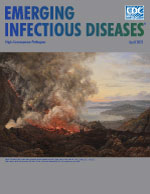
The aim of this prospective study was to assess the risk for tickborne infections after a tick bite. A total of 489 persons bitten by 1,295 ticks were assessed for occurrence of infections with Borrelia burgdorferi sensu lato, Anaplasma phagocytophilum, Rickettsia spp., Babesia spp., Candidatus Neoehrlichia mikurensis, and relapsing fever borreliae. B. burgdorferi s.l. infection was found in 25 (5.1%) participants, of whom 15 had erythema migrans. Eleven (2.3%) participants were positive by PCR for Candidatus N. mikurensis. One asymptomatic participant infected with B. miyamotoi was identified. Full engorgement of the tick (odds ratio 9.52) and confirmation of B. burgdorferi s.l. in the tick by PCR (odds ratio 4.39) increased the risk for infection. Rickettsia helvetica was highly abundant in ticks but not pathogenic to humans. Knowledge about the outcome of tick bites is crucial because infections with emerging pathogens might be underestimated because of limited laboratory facilities.
| EID | Markowicz M, Schötta A, Höss D, Kundi M, Schray C, Stockinger H, et al. Infections with Tickborne Pathogens after Tick Bite, Austria, 2015–2018. Emerg Infect Dis. 2021;27(4):1048-1056. https://doi.org/10.3201/eid2704.203366 |
|---|---|
| AMA | Markowicz M, Schötta A, Höss D, et al. Infections with Tickborne Pathogens after Tick Bite, Austria, 2015–2018. Emerging Infectious Diseases. 2021;27(4):1048-1056. doi:10.3201/eid2704.203366. |
| APA | Markowicz, M., Schötta, A., Höss, D., Kundi, M., Schray, C., Stockinger, H....Stanek, G. (2021). Infections with Tickborne Pathogens after Tick Bite, Austria, 2015–2018. Emerging Infectious Diseases, 27(4), 1048-1056. https://doi.org/10.3201/eid2704.203366. |
Unsafe injection practices and injection drug use have been linked to multiple HIV outbreaks in Pakistan since 2003; however, few studies have systematically analyzed the causes of these outbreaks. We conducted a systematic review of published English-language literature indexed in bibliographic databases and search engines and a focused gray literature review to collate and analyze all reported HIV outbreaks in Pakistan during 2000–2019. Of 774 unique publications reviewed, we identified 25 eligible publications describing 7 outbreaks. More than half occurred during 2016–2019. The primary sources of transmission were iatrogenic transmission, affecting children, persons with chronic medical conditions, and the general population (4 outbreaks); injection drug use (2 outbreaks); and a combination of both (1 outbreak). In the absence of robust HIV testing and surveillance in Pakistan, timely and detailed outbreak reporting is important to understand the epidemiology of HIV in the country.
| EID | Rabold EM, Ali H, Fernandez D, Knuth M, Schenkel K, Asghar R, et al. Systematic Review of Reported HIV Outbreaks, Pakistan, 2000–2019. Emerg Infect Dis. 2021;27(4):1039-1047. https://doi.org/10.3201/eid2704.204205 |
|---|---|
| AMA | Rabold EM, Ali H, Fernandez D, et al. Systematic Review of Reported HIV Outbreaks, Pakistan, 2000–2019. Emerging Infectious Diseases. 2021;27(4):1039-1047. doi:10.3201/eid2704.204205. |
| APA | Rabold, E. M., Ali, H., Fernandez, D., Knuth, M., Schenkel, K., Asghar, R....Morgan, O. (2021). Systematic Review of Reported HIV Outbreaks, Pakistan, 2000–2019. Emerging Infectious Diseases, 27(4), 1039-1047. https://doi.org/10.3201/eid2704.204205. |
Blastomycosis is caused by inhalation of Blastomyces spp. fungi. Limited data are available on the incidence and geographic range of blastomycosis in the United States. To better characterize its epidemiologic features, we analyzed combined surveillance data from the 5 states in which blastomycosis is reportable: Arkansas, Louisiana, Michigan, Minnesota, and Wisconsin. Surveillance identified 4,441 cases during 1987–2018, a mean of 192 cases per year. The mean annual incidence was <1 case/100,000 population in most areas but >20 cases/100,000 population in some northern counties of Wisconsin. Median patient age was 46 years, 2,892 (65%) patients were male, 1,662 (57%) were hospitalized, and 278 (8%) died. The median time from symptom onset to diagnosis was 33 days. The severity of illness and diagnostic delays suggest that surveillance underestimates the true number of cases. More in-depth surveillance in additional states could elucidate blastomycosis incidence and inform efforts to increase awareness.
| EID | Benedict K, Gibbons-Burgener S, Kocharian A, Ireland M, Rothfeldt L, Christophe N, et al. Blastomycosis Surveillance in 5 States, United States, 1987–2018. Emerg Infect Dis. 2021;27(4):999-1006. https://doi.org/10.3201/eid2704.204078 |
|---|---|
| AMA | Benedict K, Gibbons-Burgener S, Kocharian A, et al. Blastomycosis Surveillance in 5 States, United States, 1987–2018. Emerging Infectious Diseases. 2021;27(4):999-1006. doi:10.3201/eid2704.204078. |
| APA | Benedict, K., Gibbons-Burgener, S., Kocharian, A., Ireland, M., Rothfeldt, L., Christophe, N....Jackson, B. R. (2021). Blastomycosis Surveillance in 5 States, United States, 1987–2018. Emerging Infectious Diseases, 27(4), 999-1006. https://doi.org/10.3201/eid2704.204078. |
Volume 27, Number 3—March 2021
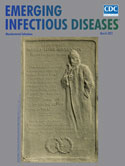
We investigated the clinical outcomes and molecular mechanisms of fluconazole-resistant (FR) Candida glabrata bloodstream infections. Among 1,158 isolates collected during multicenter studies in South Korea during 2008–2018, 5.7% were FR. For 64 patients with FR bloodstream infection isolates, the 30-day mortality rate was 60.9% and the 90-day mortality rate 78.2%; these rates were significantly higher than in patients with fluconazole-susceptible dose-dependent isolates (30-day mortality rate 36.4%, 90-day mortality rate 43.8%; p<0.05). For patients with FR isolates, appropriate antifungal therapy was the only independent protective factor associated with 30-day (hazard ratio 0.304) and 90-day (hazard ratio 0.310) mortality. Sequencing of pleiotropic drug-resistance transcription factor revealed that 1–2 additional Pdr1p amino acid substitutions (except genotype-specific Pdr1p amino acid substitutions) occurred in 98.5% of FR isolates but in only 0.9% of fluconazole-susceptible dose-dependent isolates. These results highlight the high mortality rate of patients infected with FR C. glabrata BSI isolates harboring Pdr1p mutations.
| EID | Won E, Choi MJ, Kim M, Yong D, Lee W, Uh Y, et al. Fluconazole-Resistant Candida glabrata Bloodstream Isolates, South Korea, 2008–2018. Emerg Infect Dis. 2021;27(3):779-788. https://doi.org/10.3201/eid2703.203482 |
|---|---|
| AMA | Won E, Choi MJ, Kim M, et al. Fluconazole-Resistant Candida glabrata Bloodstream Isolates, South Korea, 2008–2018. Emerging Infectious Diseases. 2021;27(3):779-788. doi:10.3201/eid2703.203482. |
| APA | Won, E., Choi, M. J., Kim, M., Yong, D., Lee, W., Uh, Y....Shin, J. (2021). Fluconazole-Resistant Candida glabrata Bloodstream Isolates, South Korea, 2008–2018. Emerging Infectious Diseases, 27(3), 779-788. https://doi.org/10.3201/eid2703.203482. |
In Karachi, Pakistan, a South Asian megacity with a high prevalence of tuberculosis (TB) and low HIV prevalence, we assessed the effectiveness of fluoroquinolone-based preventive therapy for drug-resistant (DR) TB exposure. During February 2016–March 2017, high-risk household contacts of DR TB patients began a 6-month course of preventive therapy with a fluoroquinolone-based, 2-drug regimen. We assessed effectiveness in this cohort by comparing the rate and risk for TB disease over 2 years to the rates and risks reported in the literature. Of 172 participants, TB occurred in 2 persons over 336 person-years of observation. TB disease incidence rate observed in the cohort was 6.0/1,000 person-years. The incidence rate ratio ranged from 0.29 (95% CI 0.04–1.3) to 0.50 (95% CI 0.06–2.8), with a pooled estimate of 0.35 (95% CI 0.14–0.87). Overall, fluoroquinolone-based preventive therapy for DR TB exposure reduced risk for TB disease by 65%.
| EID | Malik AA, Gandhi NR, Lash TL, Cranmer LM, Omer SB, Ahmed JF, et al. Effectiveness of Preventive Therapy for Persons Exposed at Home to Drug-Resistant Tuberculosis, Karachi, Pakistan. Emerg Infect Dis. 2021;27(3):805-812. https://doi.org/10.3201/eid2703.203916 |
|---|---|
| AMA | Malik AA, Gandhi NR, Lash TL, et al. Effectiveness of Preventive Therapy for Persons Exposed at Home to Drug-Resistant Tuberculosis, Karachi, Pakistan. Emerging Infectious Diseases. 2021;27(3):805-812. doi:10.3201/eid2703.203916. |
| APA | Malik, A. A., Gandhi, N. R., Lash, T. L., Cranmer, L. M., Omer, S. B., Ahmed, J. F....Becerra, M. C. (2021). Effectiveness of Preventive Therapy for Persons Exposed at Home to Drug-Resistant Tuberculosis, Karachi, Pakistan. Emerging Infectious Diseases, 27(3), 805-812. https://doi.org/10.3201/eid2703.203916. |
Volume 27, Number 2—February 2021
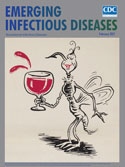
After Zika virus (ZIKV) infection in Costa Rica was confirmed in January 2016, the national surveillance system was enhanced to monitor associated birth defects. To characterize the ZIKV outbreak among live-born infants during March 2016–March 2018, we conducted a descriptive analysis. Prevalence of ZIKV-associated birth defects was 15.3 cases/100,000 live births. Among 22 infants with ZIKV-associated birth defects, 11 were designated as confirmed (positive for ZIKV) and 11 were designated as probable cases (negative for ZIKV or not tested, but mother was expsed to ZIKV during pregnancy). A total of 91% had microcephaly (head circumference >2 SDs below mean for age and sex), 64% severe microcephaly (head circumference >3 SDs below mean for age and sex), 95% neurodevelopmental abnormalities, 82% brain anomalies, 41% eye abnormalities, and 9% hearing loss. Monitoring children for >1 year can increase identification of ZIKV-associated abnormalities in addition to microcephaly.
| EID | Benavides-Lara A, la Paz Barboza-Arguello Md, González-Elizondo M, Hernández-deMezerville M, Brenes-Chacón H, Ramírez-Rojas M, et al. Zika Virus–Associated Birth Defects, Costa Rica, 2016–2018. Emerg Infect Dis. 2021;27(2):360-371. https://doi.org/10.3201/eid2702.202047 |
|---|---|
| AMA | Benavides-Lara A, la Paz Barboza-Arguello Md, González-Elizondo M, et al. Zika Virus–Associated Birth Defects, Costa Rica, 2016–2018. Emerging Infectious Diseases. 2021;27(2):360-371. doi:10.3201/eid2702.202047. |
| APA | Benavides-Lara, A., la Paz Barboza-Arguello, M. d., González-Elizondo, M., Hernández-deMezerville, M., Brenes-Chacón, H., Ramírez-Rojas, M....Soriano-Fallas, A. (2021). Zika Virus–Associated Birth Defects, Costa Rica, 2016–2018. Emerging Infectious Diseases, 27(2), 360-371. https://doi.org/10.3201/eid2702.202047. |
We retrospectively analyzed epidemiologic, clinical, and biologic characteristics of 368 Plasmodium ovale wallikeri and 309 P. ovale curtisi infections treated in France during January 2013–December 2018. P. ovale wallikeri infections displayed deeper thrombocytopenia and shorter latency periods. Despite similar clinical manifestations, P. ovale wallikeri–infected patients were more frequently treated with artemisinin-based combination therapy. Although the difference was not statistically significant, P. ovale wallikeri–infected patients were 5 times more frequently hospitalized in intensive care or intermediate care and had a higher proportion of severe thrombocytopenia than P. ovale curtisi–infected patients. Rapid diagnostic tests that detect aldolase were more efficient than those detecting Plasmodium lactate dehydrogenase. Sequence analysis of the potra gene from 90 P. ovale isolates reveals an insufficient polymorphism for relapse typing.
| EID | Joste V, Bailly J, Hubert V, Pauc C, Gendrot M, Guillochon E, et al. Plasmodium ovale wallikeri and P. ovale curtisi Infections and Diagnostic Approaches to Imported Malaria, France, 2013–2018. Emerg Infect Dis. 2021;27(2):372-384. https://doi.org/10.3201/eid2702.202143 |
|---|---|
| AMA | Joste V, Bailly J, Hubert V, et al. Plasmodium ovale wallikeri and P. ovale curtisi Infections and Diagnostic Approaches to Imported Malaria, France, 2013–2018. Emerging Infectious Diseases. 2021;27(2):372-384. doi:10.3201/eid2702.202143. |
| APA | Joste, V., Bailly, J., Hubert, V., Pauc, C., Gendrot, M., Guillochon, E....Houzé, S. (2021). Plasmodium ovale wallikeri and P. ovale curtisi Infections and Diagnostic Approaches to Imported Malaria, France, 2013–2018. Emerging Infectious Diseases, 27(2), 372-384. https://doi.org/10.3201/eid2702.202143. |
Volume 27, Number 1—January 2021
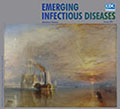
Invasive fusariosis (IF) is associated with severe neutropenia in patients with concurrent hematologic conditions. We conducted a retrospective observational study to characterize the epidemiology of IF in 18 Spanish hospitals during 2000–2015. In that time, the frequency of IF in nonneutropenic patients increased from 0.08 cases per 100,000 admissions in 2000–2009 to 0.22 cases per 100,000 admissions in 2010–2015. Nonneutropenic IF patients often had nonhematologic conditions, such as chronic cardiac or lung disease, rheumatoid arthritis, history of solid organ transplantation, or localized fusariosis. The 90-day death rate among nonneutropenic patients (28.6%) and patients with resolved neutropenia (38.1%) was similar. However, the death rate among patients with persistent neutropenia (91.3%) was significantly higher. We used a multivariate Cox regression analysis to characterize risk factors for death: persistent neutropenia was the only risk factor for death, regardless of antifungal therapy.
| EID | Pérez-Nadales E, Alastruey-Izquierdo A, Linares-Sicilia M, Soto-Debrán J, Abdala E, García-Rodríguez J, et al. Invasive Fusariosis in Nonneutropenic Patients, Spain, 2000–2015. Emerg Infect Dis. 2021;27(1):24-36. https://doi.org/10.3201/eid2701.190782 |
|---|---|
| AMA | Pérez-Nadales E, Alastruey-Izquierdo A, Linares-Sicilia M, et al. Invasive Fusariosis in Nonneutropenic Patients, Spain, 2000–2015. Emerging Infectious Diseases. 2021;27(1):24-36. doi:10.3201/eid2701.190782. |
| APA | Pérez-Nadales, E., Alastruey-Izquierdo, A., Linares-Sicilia, M., Soto-Debrán, J., Abdala, E., García-Rodríguez, J....Nucci, M. (2021). Invasive Fusariosis in Nonneutropenic Patients, Spain, 2000–2015. Emerging Infectious Diseases, 27(1), 24-36. https://doi.org/10.3201/eid2701.190782. |
We describe trends in acute rheumatic fever (ARF), rheumatic heart disease (RHD), and RHD deaths among population groups in New Zealand. We analyzed initial primary ARF and RHD hospitalizations during 2000–2018 and RHD mortality rates during 2000–2016. We found elevated rates of initial ARF hospitalizations for persons of Māori (adjusted rate ratio [aRR] 11.8, 95% CI 10.0–14.0) and Pacific Islander (aRR 23.6, 95% CI 19.9–27.9) ethnicity compared with persons of European/other ethnicity. We also noted higher rates of initial RHD hospitalization for Māori (aRR 3.2, 95% CI 2.9–3.5) and Pacific Islander (aRR 4.6, 95% CI 4.2–5.1) groups and RHD deaths among these groups (Māori aRR 12.3, 95% CI 10.3–14.6, and Pacific Islanders aRR 11.2, 95% CI 9.1–13.8). Rates also were higher in socioeconomically disadvantaged neighborhoods. To curb high rates of ARF and RHD, New Zealand must address increasing social and ethnic inequalities.
| EID | Bennett J, Zhang J, Leung W, Jack S, Oliver J, Webb R, et al. Rising Ethnic Inequalities in Acute Rheumatic Fever and Rheumatic Heart Disease, New Zealand, 2000–2018. Emerg Infect Dis. 2021;27(1):36-46. https://doi.org/10.3201/eid2701.191791 |
|---|---|
| AMA | Bennett J, Zhang J, Leung W, et al. Rising Ethnic Inequalities in Acute Rheumatic Fever and Rheumatic Heart Disease, New Zealand, 2000–2018. Emerging Infectious Diseases. 2021;27(1):36-46. doi:10.3201/eid2701.191791. |
| APA | Bennett, J., Zhang, J., Leung, W., Jack, S., Oliver, J., Webb, R....Baker, M. G. (2021). Rising Ethnic Inequalities in Acute Rheumatic Fever and Rheumatic Heart Disease, New Zealand, 2000–2018. Emerging Infectious Diseases, 27(1), 36-46. https://doi.org/10.3201/eid2701.191791. |
CME Articles by Volume
